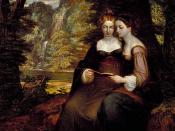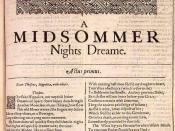As a playwright, William Shakespeare was way ahead of his time. The design he created for his plays has been used by most playwrights and authors long after his career came to an end. Some of these plays, such as A Midsummer Night's Dream, were comedies. In the design of a comedy, the lovers usually end up together and happy in the end. The theme of A Midsummer Night's Dream is that love does not make sense. Shakespeare is trying to say that love can make people act out of character and take risks that they would not normally take. Comedies also typically involve framework, lovers, comics, and supernatural beings such as fairies. All of these aspects play an intricate role in tying the story together at the end. Shakespeare's comedies are structured in Acts, with each Act broken down into smaller Scenes. Each Scene is important because a scene contributes something different to the end result of the play.
Scene two of Act three contributes to the love, comic, and supernatural aspects of A Midsummer Night's Dream and demonstrates that love does not make sense.
The play would not be nearly the same without the magical tricks the fairies perform in Act three, Scene two. Oberon, the king of the fairies, had previously ordered Puck, his mischievous jester, to cast a love spell on Demetrius so that he would fall in love with Helena, who is in love with him. In the beginning of the scene, however, Oberon discovers that Puck has mistakenly cast the spell on Lysander, who is out in the forest to marry Hermia. "What hast thou done? Thou hast mistaken quite and laid the love juice on some true love's sight. Of thy misprision must perforce ensue some true love turned and not a...


